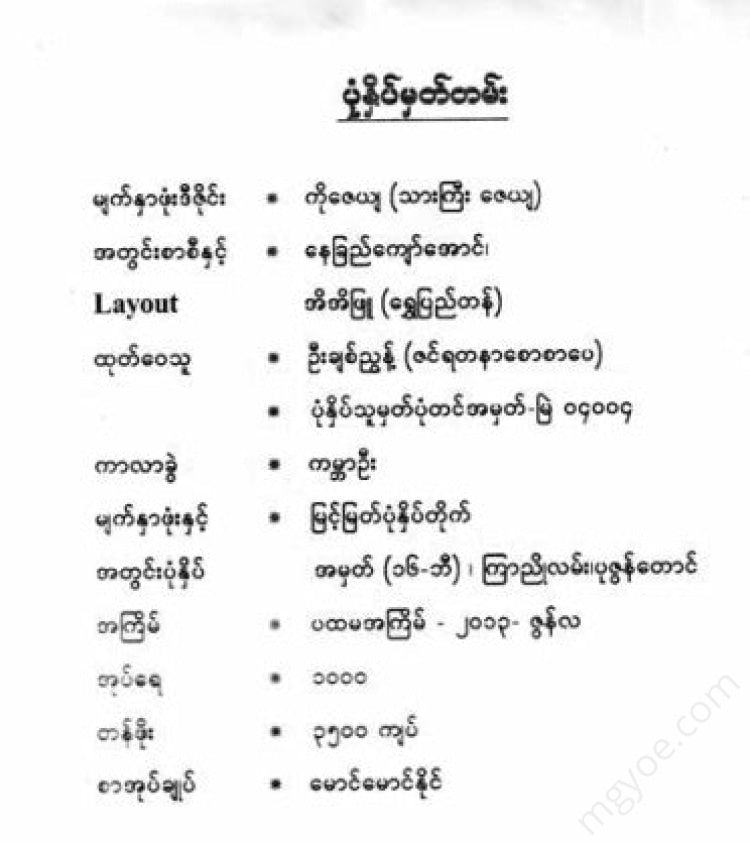Other Websites
74-75-76 Political forces - 74-75-76 Anti-dictatorship protests in Myanmar
74-75-76 Political forces - 74-75-76 Anti-dictatorship protests in Myanmar
Couldn't load pickup availability
The May-June Labor Uprising of 1974 was a major uprising in May and June 1974, during the military dictatorship of Myanmar, in which workers from almost all factories and workshops across Burma protested and fought against the military dictatorship and demanded the basic rights they were entitled to.
In that incident, the workers who peacefully protested and demanded their rights were subjected to violent repression by the military dictatorships of the 1960s and 1970s, as the saying goes, "If you ask for oil, you get rice, you get bullets."
As such a large-scale labor strike and labor uprising was crushed, the workers and the public had to pay dearly, but on the other hand, the military monstrosity of the Myanmar military dictatorship was revealed and deep dissatisfaction, dislike, resentment, and hatred against the Myanmar military dictatorship emerged not only among the workers but also among the students. After this labor uprising, student movements such as the December U Thant uprising in 1974, the June labor strike anniversary uprising (also known as the Shwedagon uprising) in 1975, and the March Hmoingya Pyae uprising in 1976, along with other student movements against the military dictatorship, the military dictatorship, and political movements also emerged in succession.
In these protests and movements, the people peacefully protested and demanded their demands. However, the military dictatorship, as usual, used weapons and violence to crush them, resulting in the deaths of hundreds and thousands of monks, students, and the general public, and in their arrests, torture, and imprisonment. Like the workers, the lives of monks, students, and the general public were sacrificed. Although our goals were not achieved due to such repression and suppression, and our desires and demands were not met, as a result of these protests, the spirit of opposing and completely eliminating the evil military dictatorship of the 1980s was deeply rooted in our hearts and in the hearts of the people. These same spirits were transmitted to our younger generation, the (88) generation, about a decade later, and the (88) Uprising emerged. Therefore, the (88) Uprising can be said to be a continuation of the uprisings that our (74-75-76) generations led and participated in.
Some historians, those who study and evaluate Myanmar's politics, domestic and international activists, and media professionals, when evaluating and portraying Myanmar's political history, have been writing as if Myanmar's military dictatorship emerged after the 1988 uprising more than 20 years ago, and that the anti-military dictatorship and pro-democracy movements also emerged during that period. There are also those who believe this.
In fact, the military dictatorship in Burma began in 1962. It has been over 50 years now. Therefore, the military dictatorships of the 1988 and 1990 were born from the 1990 and 1991 military dictatorships. They are a continuation of the 1990 and 1992 military dictatorships. The 1992 military dictatorships, like the 1990 and 1991 military dictatorships, used force and violence to oppress the people. They committed violence and violated human rights. Due to such oppression and violence, there was resistance from the oppressed people, including students and workers. Therefore, the democratic movements that have emerged since 1988 until today are a continuation of the 1988 uprising, just as the 1988 uprising is a continuation of the 1974-75-76 workers and students uprisings. Similarly, the (74-75-76) movements are a continuation of the (62-63) student movement struggles. Therefore, the point we want to emphasize here is that the (1974-75-76) labor and peasant movements and events are an important historical moment in the modern Burmese political history that cannot be forgotten.
This book was prepared and published to highlight this fact and to enable the present and future generations of Burmese politicians to learn about and pass on the political experiences of the political generation (7475-76) who opposed the military dictatorship of the 1945-1946.
This book presents the parts of the (1974-75-76) anti-government movement in four parts: the (1974-75) Labor Uprising, the (1974) December U Thant Uprising, the (1975) June Anniversary Uprising (also known as the Shwedagon Uprising), and the (1976) March Hmai Ya Pyae Uprising.
In addition, the experiences of the political forces in prison (74-75-76) and other general political movements and ideas related to the political movement (74-75-76) are presented in sections by category.
In describing the four (4) incidents, we present them side by side as news reports by sector, so that we can compare not only the experiences of those who experienced them but also the articles in newspapers at the time.
It is important to note here that most (almost all) of the contributors to this book are not writers. Some have no experience in writing at all. Their experiences are simply presented in a raw form, so there may be some inaccuracies. Furthermore, their experiences were recorded many years ago, so there may be errors, misunderstandings, and omissions. If you find any such shortcomings, we would like to ask you to forgive us on behalf of the authors.
In conclusion, I would like to express my special gratitude to all the comrades and friends who contributed to the completion of this book and to those who submitted manuscripts for this book.
Organizers 74-75-76 Political forces
June (6), 2013



